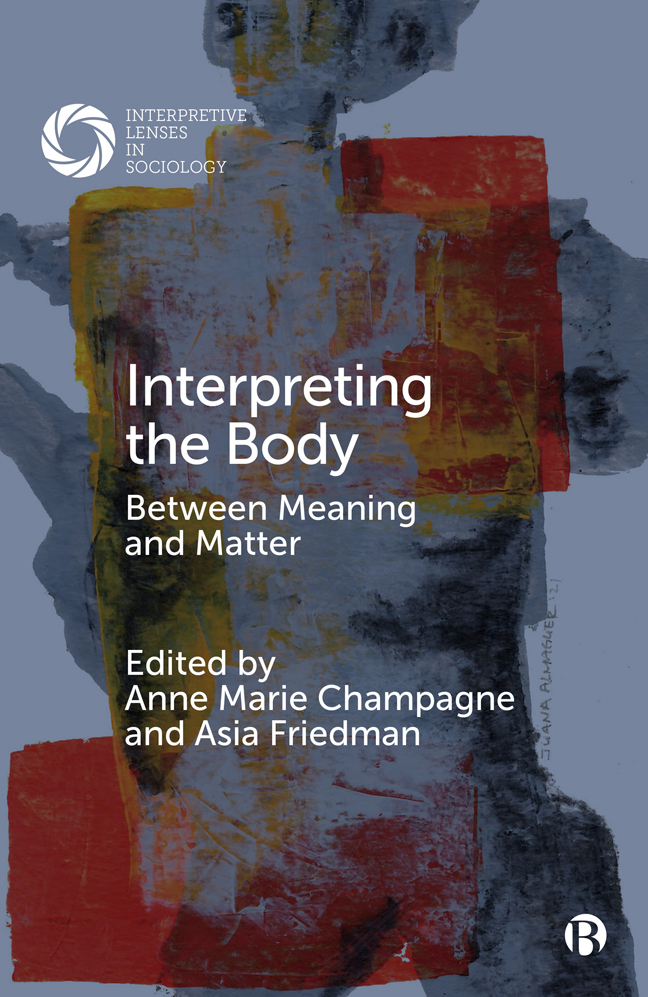Book contents
- Frontmatter
- Dedication
- Contents
- Series Editors’ Preface: Interpretive Lenses in Sociology—On the Multidimensional Foundations of Meaning in Social Life
- Notes on Contributors
- Preface and Acknowledgments
- Introduction: Between Meaning and Matter
- 1 Toward a Strong Cultural Sociology of the Body and Embodiment
- 2 Thinking the Molecular
- 3 Interpreting Africa's Seselelãme: Bodily Ways of Knowing in a Globalized World
- 4 Gender on the Post-Colony: Phenomenology, Race, and the Body in Nervous Conditions
- 5 Reinterpreting Male Bodies and Health in Crisis Times: From “Obesity” to Bigger Matters
- 6 Beauty, Breasts, and Meaning after Mastectomy
- 7 “You Are Not the Body”: (Re)Interpreting the Body in and through Integral Yoga
- 8 Black Girls’ Bodies and Belonging in the Classroom
- 9 Embodied Vulnerability and Sensemaking with Solidarity Activists
- 10 Our Bodies, Our Disciplines, Our Selves
- Index
7 - “You Are Not the Body”: (Re)Interpreting the Body in and through Integral Yoga
Published online by Cambridge University Press: 23 January 2024
- Frontmatter
- Dedication
- Contents
- Series Editors’ Preface: Interpretive Lenses in Sociology—On the Multidimensional Foundations of Meaning in Social Life
- Notes on Contributors
- Preface and Acknowledgments
- Introduction: Between Meaning and Matter
- 1 Toward a Strong Cultural Sociology of the Body and Embodiment
- 2 Thinking the Molecular
- 3 Interpreting Africa's Seselelãme: Bodily Ways of Knowing in a Globalized World
- 4 Gender on the Post-Colony: Phenomenology, Race, and the Body in Nervous Conditions
- 5 Reinterpreting Male Bodies and Health in Crisis Times: From “Obesity” to Bigger Matters
- 6 Beauty, Breasts, and Meaning after Mastectomy
- 7 “You Are Not the Body”: (Re)Interpreting the Body in and through Integral Yoga
- 8 Black Girls’ Bodies and Belonging in the Classroom
- 9 Embodied Vulnerability and Sensemaking with Solidarity Activists
- 10 Our Bodies, Our Disciplines, Our Selves
- Index
Summary
From my field notes, Integral Yoga Institute, May– June 2012, lightly edited for meaning:
On the first Saturday of the Integral Yoga Institute's (IYI) teacher training program, the teacher trainees (TTs), myself included, saon yoga mats arranged around the edges of Ron's living room, which had been cleared of almost all its furniture to make room for the eight TTs and two teachers. Ron and Aadesh, the program's instructors, sat at the front of the room beside a customary Integral Yoga altar: a small rectangular table draped with a burgundy cloth, which held a lit candle in a lotus flower shaped holder and two framed pictures, one of Swami Satchidananda, the founder of Integral Yoga, and one of his guru, Swami Sivananda. The TTs were told that we would spend most of the day's class on the “Sun Salutation Drill,” and there was nervous chitchat and laughter among the students as we looked over the handout explaining what we were about to do. The Sun Salutation drill is a method, designed by Aadesh, to help TTs learn as quickly as possible the verbal instructions for teaching Surya Namaskar (the sun salutation): a series of twelve postures that the practitioner moves through in sequence, flowing smoothly from one posture into the next (see Figure 7.1).
Aadesh began, however, by talking about the body and our (ideal) relationship to it. “We are not the body,” he remarked, “even though we tend to identify with it.” During an IY (Integral Yoga) class, he elaborated, we want to help students “feel a little free of that [identification] … so we use the word ‘the’ in place of ‘you’ or ‘your’ when referring to students’ bodies.” Rather than say to a student “lift your arms,” the TTs are taught to instruct the student to “lift the arms.” Part of the goal of an Integral Yoga Hatha class, Aadesh continued, is “to get people to become aware of their Eternal Self, their soul; to let go of their engagement with the body, the mind, and become lucidly aware of this Self.” Ron shook his head in agreement, adding that this shift in language really does help students get “into that mindset,” and ultimately will help them move closer to achieving yoga (i.e., a sense of union with the divine).
With this objective in mind, we moved into the sun salutation drill.
- Type
- Chapter
- Information
- Interpreting the BodyBetween Meaning and Matter, pp. 155 - 177Publisher: Bristol University PressPrint publication year: 2023



